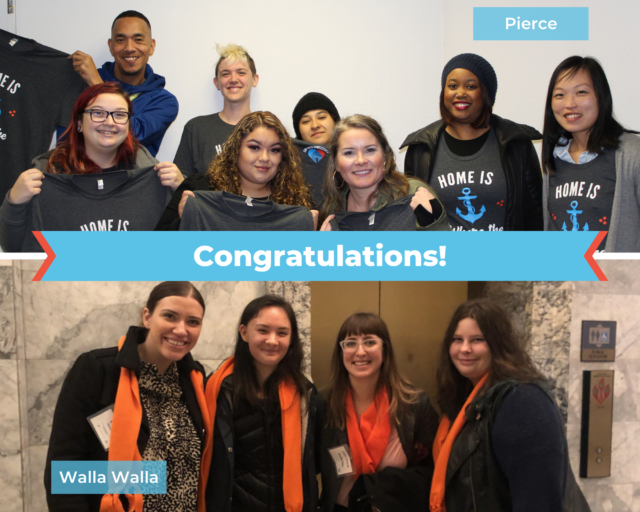For the past ten months, our four Anchor Communities have had a singular focus: answering yes to all questions on the Youth and Young Adult By-Name List scorecard and reaching quality, real-time data. In February, two of our Anchor Communities reached exciting milestones: Walla Walla became the first Anchor Community to say yes to all 41 required questions in the scorecard, and Pierce became the third community in the nation to reach quality, real-time data for youth and young adults! This means that at any given time, Pierce County knows how many unaccompanied youth and young adults are experiencing homelessness.
To get where they are today, Pierce and Walla Walla made major systemic changes. Pierce engaged their local child welfare, juvenile justice and education systems, and they worked closely with young people to learn how to make services more accessible. The community streamlined the process of identifying young people experiencing homelessness and adding them to the By-Name List by embedding members of their ACT team, a youth and young adult outreach team operated by the REACH Center, across all systems. They also co-created focus groups and surveys with young people, allowing them to confirm what aspects of services are working for young people and to implement changes where needed.
In Walla Walla, the community was able to fund their first ever outreach program with the help of the $1 million secured for Anchor Communities in the state budget. Blue Mountain Action Council (BMAC) hired two Navigators, enabling the community to reach full outreach coverage. The team also benefitted from the consistent participation of two young adult team members, Charlene and Carla, who held focus groups to gather young people’s input on outreach strategies and the system. Team members also stepped up to fill gaps in capacity, like Coordinator Samantha Jackle filling the role of HMIS data lead, attending trainings and working with the Department of Commerce to learn the skills needed for the task.

Saying yes to all questions on the scorecard puts infrastructure in place to help communities better understand how their systems are serving all young people, especially those who have been historically marginalized. This information is crucial as communities move towards the goal of ending youth and young adult homelessness by 2022.
After completing the scorecard, Anchor Communities keep submitting monthly data on the number of young people who enter, exit and are actively homeless. Data must be balanced for three months to confirm its reliability. Pierce County has reached this milestone, meaning they’ve reached quality data! This means that their data accurately reflects the number of young people experiencing homelessness in real time.
Without a robust data infrastructure, young people can fall through the cracks, particularly if they were not accessing any services. Since data has a significant impact on the future allotment of funding for social services, this lack of clarity has dire consequences. Quality data allows communities to better understand how funding and resources should be allocated, and to identify disparities in outcomes for young people of color and LGBTQ+ young people. It is a critical component of ending homelessness.
Now that Pierce County has reached quality data, they will be able to evaluate the effectiveness of their solutions using dashboards designed by our Data & Evaluation Director, Liz, with visualization software from the Tableau Foundation. Data analytics will tell us if a project leads to a reduction in the number of young people who are experiencing homelessness. When data shows that a project has led to a reduction, it is an indicator that the project was effective and that we are moving in the right direction to reach Yes to Yes.

Leave a Reply